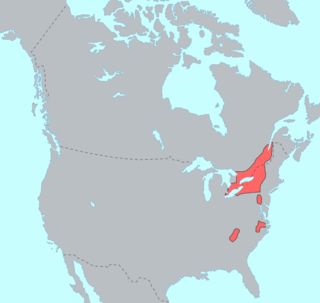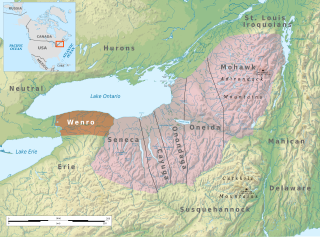
The Wyandot people are Indigenous peoples of the Northeastern Woodlands of North America, and speakers of an Iroquoian language, Wyandot.

Georgian Bay is a large bay of Lake Huron, in the Laurentia bioregion. It is located entirely within the borders of Ontario, Canada. The main body of the bay lies east of the Bruce Peninsula and Manitoulin Island. To its northwest is the North Channel.

The Beaver Wars, also known as the Iroquois Wars or the French and Iroquois Wars were a series of conflicts fought intermittently during the 17th century in North America throughout the Saint Lawrence River valley in Canada and the Great Lakes region which pitted the Iroquois against the Hurons, northern Algonquians and their French allies. As a result of this conflict, the Iroquois destroyed several confederacies and tribes through warfare: the Hurons or Wendat, Erie, Neutral, Wenro, Petun, Susquehannock, Mohican and northern Algonquins whom they defeated and dispersed, some fleeing to neighbouring peoples and others assimilated, routed, or killed.

The Iroquoian languages are a language family of indigenous peoples of North America. They are known for their general lack of labial consonants. The Iroquoian languages are polysynthetic and head-marking.
Auoindaon was the native chief of the Wyandot (Huron) at Quieunonascaranas, a settlement in Wendake near modern-day Midland, Ontario, Canada. He made alliances with and became quite fond of French priests serving as missionaries in the area, one of the most notable being Gabriel Sagard. Upon first encountering Sagard, the Huron community at Quieunonascaranas all came out to greet him. Quieunonascaranas was a village settled by the Huron community and led by chief Auoindaon, in 1623 the settlement consisted of about 300 households and almost 40 lodges.

The Neutral Confederacy was a tribal confederation of Iroquoian peoples. Its heartland was in the floodplain of the Grand River in what is now Ontario, Canada. At its height, its wider territory extended toward the shores of lakes Erie, Huron, and Ontario, as well as the Niagara River in the east. To the northeast were the neighbouring territories of Huronia and the Petun Country, which were inhabited by other Iroquoian confederacies from which the term Neutrals Attawandaron was derived. The five-nation Iroquois Confederacy was across Lake Ontario to the southeast.

Sainte-Marie among the Hurons was a French Jesuit settlement in Huronia or Wendake, the land of the Wendat, near modern Midland, Ontario, from 1639 to 1649. It was the first European settlement in what is now the province of Ontario. Eight missionaries from Sainte-Marie were martyred, and were canonized by the Catholic Church in 1930. Sainte-Marie Among the Hurons was designated a National Historic Site of Canada in 1920. A reconstruction of the mission now operates as a living museum.

Wendake is the current name for two urban reserves, Wendake 7 and Wendake 7A, of the Huron-Wendat Nation in the Canadian province of Quebec. They are enclaves entirely surrounded by the La Haute-Saint-Charles borough of Quebec City, within the former city of Loretteville. One of the Seven Nations of Canada, the settlement was formerly known as Village-des-Hurons, and also as (Jeune)-Lorette.
The Huron-Wendat Nation is an Iroquoian-speaking nation that was established in the 17th century. In the French language, used by most members of the First Nation, they are known as the Nation Huronne-Wendat. The French gave the nickname “Huron” to the Wendat, meaning “boar's head” because of the hairstyle of Huron men. Wendat (Quendat) was their confederacy name, meaning “people of the island” or "dwellers on a peninsula."

The Wyandotte Nation is a federally recognized Native American tribe headquartered in northeastern Oklahoma. They are descendants of the Wendat Confederacy and Native Americans with territory near Georgian Bay and Lake Huron. Under pressure from Haudenosaunee and other tribes, then from European settlers and the United States government, the tribe gradually moved south and west to Michigan, Ohio, Kansas, and finally Oklahoma in the United States.

Tiny, also known as Tiny Township, is a township in Simcoe County, south-central Ontario, Canada. The Township of Tiny can be found in the southern Georgian Bay region and is approximately 30 kilometres (19 mi) long or 410 square kilometres (160 sq mi).

Nottawasaga Bay is a sub-bay within Georgian Bay in Southern Ontario, Canada located at the southernmost end of the main bay. The communities located on Nottawasaga Bay are Meaford, The Blue Mountains, Collingwood, Wasaga Beach and Tiny.
The St. Lawrence Iroquoians were an Iroquoian Indigenous people who existed from the 14th century to about 1580. They concentrated along the shores of the St. Lawrence River in present-day Quebec and Ontario, Canada, and in the American states of New York and northernmost Vermont. They spoke Laurentian languages, a branch of the Iroquoian family.

The Petun, also known as the Tobacco people or Tionontati ,(Dionnontate, Etionontate, Etionnontateronnon, Tuinontatek, Dionondadie,or Khionotaterrhonon), were an indigenous Iroquoian people of the woodlands of eastern North America. Their last known traditional homeland was south of Lake Huron's Georgian Bay, in what is today's Canadian province of Ontario

The Wenrohronon or Wenro people were an Iroquoian indigenous nation of North America, originally residing in present-day western New York, who were conquered by the Confederation of the Five Nations of the Iroquois in two decisive wars between 1638–1639 and 1643. This was likely part of the Iroquois Confederacy campaign against the Neutral people, another Iroquoian-speaking tribe, which lived across the Niagara River. This warfare was part of what was known as the Beaver Wars, as the Iroquois worked to dominate the lucrative fur trade. They used winter attacks, which were not usual among Native Americans, and their campaigns resulted in attrition of both the larger Iroquoian confederacies, as they had against the numerous Huron.
The Draper Site is a precontact period Huron-Wendat ancestral village located on a tributary of West Duffins Creek in present-day Pickering, Ontario, approximately 35 kilometres northeast of Toronto. The site is found in a wooded area on existing farmland and may be reached by walking from the end of North Road.

The Aurora Site, also known as the "Old Fort", "Old Indian Fort", "Murphy Farm" or "Hill Fort" site, is a sixteenth-century Huron-Wendat ancestral village located on one of the headwater tributaries of the East Holland River on the north side of the Oak Ridges Moraine in present-day Whitchurch–Stouffville, approximately 30 kilometres north of Toronto. This Huron ancestral village was located on 3.4 hectares of land and the settlement was fortified with multiple rows of palisades.

The Ratcliff or Baker Hill Site is a 16th-century Huron-Wendat ancestral village located on one of the headwater tributaries of the Rouge River on the south side of the Oak Ridges Moraine in present-day Whitchurch–Stouffville, approximately 25 kilometers north of Toronto. The Ratcliff Site is located on the east side of Highway 48, south of Bloomington Road in Whitchurch–Stouffville. The ravine on the village site was infilled during the early 1950s to allow for the expansion of a neighboring quarry.
The Huron Feast of the Dead was a mortuary custom of the Wyandot people of what is today central Ontario, Canada, which involved the disinterment of deceased relatives from their initial individual graves followed by their reburial in a final communal grave. A time for both mourning and celebration, the custom became spiritually and culturally significant.

The Iroquoian peoples are an ethnolinguistic group of peoples from eastern North America. Their traditional territories, often referred to by scholars as Iroquoia, stretch from the mouth of the St. Lawrence River in the north, to modern-day North Carolina in the south.













